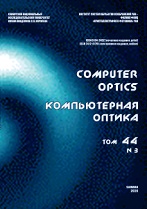|
This article is cited in 1 scientific paper (total in 1 paper)
DIFFRACTIVE OPTICS, OPTICAL TECHNOLOGIES
Computational and experimental studies on SnO2 thin films at various temperatures
K. Gurushankarab, M. Grishinaa, M. Gohulkumarc, K. Kannand
a South Ural State University, Chelyabinsk
b Department of Physics, Kalasalingam Academy of Research and Education, 626126, Krishnankoil, Tamilnadu, India
c Vivekanandha College of Arts and Science for Women, Tiruchengode, Tamil Nadu, India
d School of Advanced Materials Science and Engineering, Kumoh National Institute of Technology, 61 Daehak-ro, Gumi-si, Gyeongbuk, Republic of Korea
Abstract:
Tin oxide (SnO$_2$) thin films was prepared by dip-coating technique at various bath temperatures (313, 333, 353 and 373 K) and annealed at 673 K in this study. And the obtained results were studied and correlated with the computational method. Scanning electron microscopy (SEM) investigation demonstrated that the prepared samples are spherical with agglomeration. The elemental analysis (EDAX) confirms the presence of Sn and O. Further, the SnO$_2$ thin films microstructures are simulated, their thermodynamic and surface properties have been calculated. Micro-Raman spectra were recorded for the prepared samples. Micro-Raman results exhibit the first-order Raman mode E$_{1g}$ (475 cm$^{-1})$ indicating that the grown SnO$_2$ belongs to the rutile structure. In addition, the envelope method used for studying optical characteristics of the thin films from the transmittance spectra. The semiconducting nature of the films has been noticed from linear I-V characteristics. Furthermore, the electrical conductivity studies suggest that the highest conductivity samples acquire the lowest activation energy and their values are also in the semiconducting range.
Keywords:
SnO$_2$ thin films, dip-coating technique, computational method, thermodynamic and surface characteristics, gibbs free energy and electrical conductivity
Received: 22.04.2022
Accepted: 22.09.2022
Citation:
K. Gurushankar, M. Grishina, M. Gohulkumar, K. Kannan, “Computational and experimental studies on SnO2 thin films at various temperatures”, Computer Optics, 47:1 (2023), 53–61
Linking options:
https://www.mathnet.ru/eng/co1102 https://www.mathnet.ru/eng/co/v47/i1/p53
|

|




 Contact us:
Contact us: Terms of Use
Terms of Use
 Registration to the website
Registration to the website Logotypes
Logotypes








 Citation in format
Citation in format 
